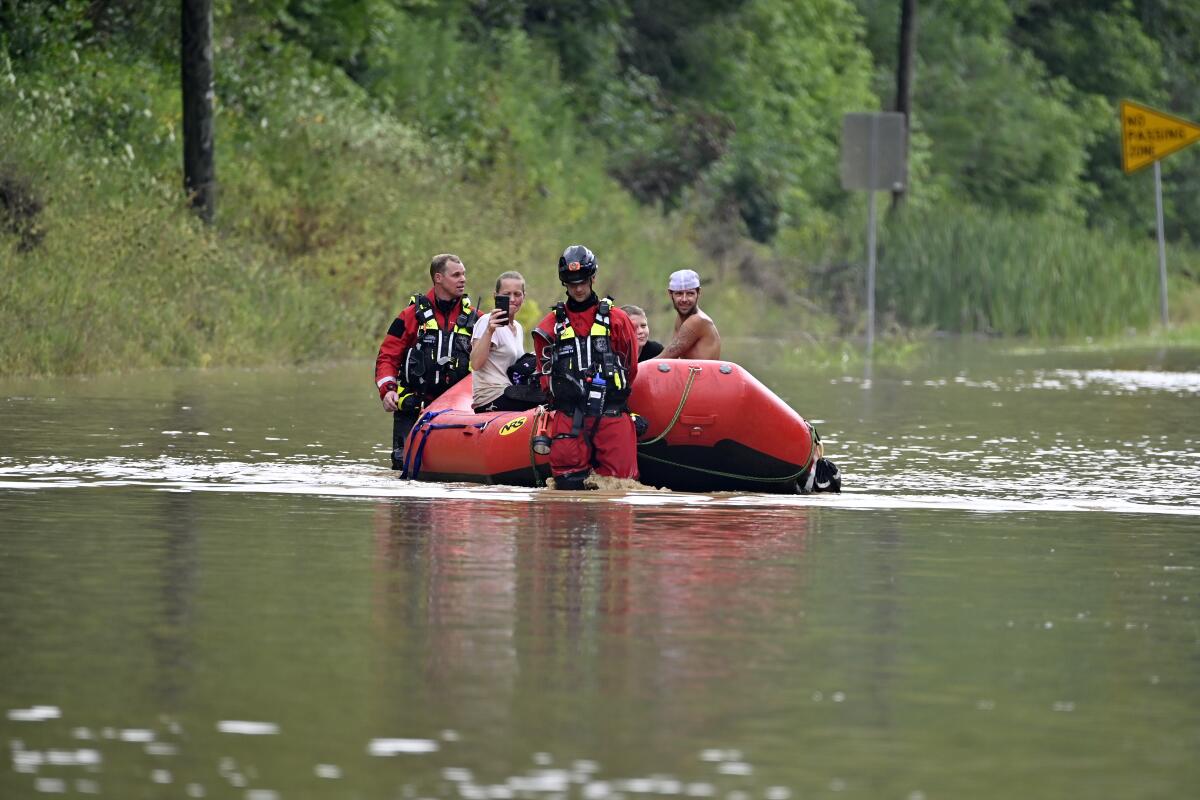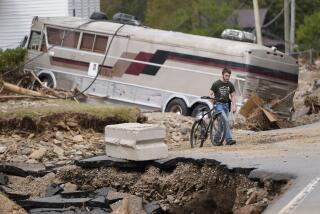Kentucky flooding deaths expected to climb, with more rain forecast

- Share via
JACKSON, Ky. — Trapped homeowners swam to safety and others were rescued by boat as record flash flooding killed at least 16 people in Kentucky and swamped entire Appalachian towns, prompting a frenzied search for survivors Friday through some of the poorest communities in America.
Authorities warned the death toll would likely grow sharply as searching continued. The rain let up early Friday, but some waterways were not expected to crest until Saturday, and more storms were forecast for the region early next week.
The storm was the latest in a string of deluges that have hammered parts of the U.S. this summer, including St. Louis earlier this week and again on Friday.
Scientists warn climate change is making such disasters more common.
Water poured down hillsides and swelled creeks and streams running through small towns. The torrent engulfed homes and businesses, trashed vehicles and caused mudslides that left people marooned on slopes.
Rescue teams backed by the National Guard used helicopters and boats to search for the missing, but some areas remained inaccessible.
Kentucky Gov. Andy Beshear said that the death toll was “going to get a lot higher” and that it could take weeks to account for all of the victims.
Patricia Colombo, 63, of Hazard, Ky., began to panic after her car stalled in floodwater on a state highway Thursday and water started rushing in. She waved down a helicopter, whose crew radioed a team on the ground that pulled her from her car.
She stayed the night at her fiance’s Jackson home, where they took turns sleeping and checking the water level with flashlights. Colombo said those who were already struggling before the floods had it worse.
“Many of these people cannot recover out here. They have homes that are half underwater,” she said.
The water came into Rachel Patton’s home in Floyd County so quickly that her mother, who is on oxygen, had to be evacuated on a door used as a raft. Patton’s voice faltered as she described their escape.
“We had to swim out, and it was cold. It was over my head, so it was — it was scary,” she told WCHS news.
The governor told the Associated Press that at least two children were among those killed and that the toll could more than double as rescuers reach more areas.
At least 33,000 utility customers lost power as the flooding extended into western Virginia and southern West Virginia, a region where poverty is endemic.
“There are hundreds of families that have lost everything,” Beshear said. “And many of these families didn’t have much to begin with. And so it hurts even more. But we’re going to be there for them.”
Extreme rain events have become more common as climate change bakes the planet and alters weather patterns, scientists say. The dynamic presents a growing challenge, because models used to predict storms’ impact are based partly on past events, and can’t keep up with increasingly devastating flash floods, hurricanes and heat waves.
“This is what climate change looks like,” meteorologist and Weather Underground founder Jeff Masters said of the Appalachian and Midwest flooding. “These extreme rainfall events are the type you would expect to see in a warming world.”
On Wednesday, the National Weather Service predicted only a “slight to moderate risk of flash flooding” in Appalachia on Thursday.
The deluge came two days after record rains around St. Louis dropped over 12 inches and killed at least two people. Last month, heavy rain on mountain snow in Yellowstone National Park triggered historic flooding and the evacuation of over 10,000 people. In both instances, the rain and flooding far exceeded what forecasters had predicted.
The floodwaters in Appalachia were so swift that some residents trapped in their homes had yet to be reached, said Floyd County official Robbie Williams.
In hard-hit Perry County, officials said some people were unaccounted for and almost everyone had suffered some sort of damage.
“We’ve still got a lot of searching to do,” said Jerry Stacy, county emergency management director. “We still have missing people.”
Over 290 people in Kentucky had sought shelter, Beshear said. He opened an online portal for donations to victims amid extensive property damage.
President Biden called to express his support for the recovery effort, Beshear said, predicting it would take over a year to rebuild.
Biden also declared a federal disaster to direct relief money to over a dozen Kentucky counties. Federal Emergency Management Agency leader Deanne Criswell said FEMA would bring whatever resources were necessary to support search and recovery efforts.
Beshear’s initial plans to tour the disaster area Friday were postponed due to unsafe conditions at an airport where he was to land, his office said. He got a look at the flooding from a helicopter later in the day.
The governor said he saw “hundreds of homes, the ballfields, the parks, businesses — under more water than I think any of us have ever seen in that area. Absolutely impassable in numerous spots.”
Parts of at least 28 state roads were blocked due to flooding or mudslides, he said.
In Virginia and West Virginia, rescue crews worked to reach people where roads weren’t passable.
West Virginia Gov. Jim Justice declared a state of emergency for six counties where flooding had downed trees, causing power outages and blocking roads. Virginia Gov. Glenn Youngkin also made an emergency declaration, enabling officials to mobilize resources across his state’s flooded southwestern area.
Forecasters said another storm front that was adding to St. Louis flood victims’ misery Friday could bring more thunderstorms to the Appalachians within days.
The hardest-hit areas of eastern Kentucky received between 8 and 10½ inches of rain over a 48-hour period ending Thursday, said National Weather Service meteorologist Brandon Bonds.
The North Fork of the Kentucky River broke records in at least two places. A river gauge recorded 20.9 feet in Whitesburg, more than 6 feet above the previous record, and the river crested at a record 43.5 feet in Jackson, Bonds said.
More to Read
Sign up for Essential California
The most important California stories and recommendations in your inbox every morning.
You may occasionally receive promotional content from the Los Angeles Times.










